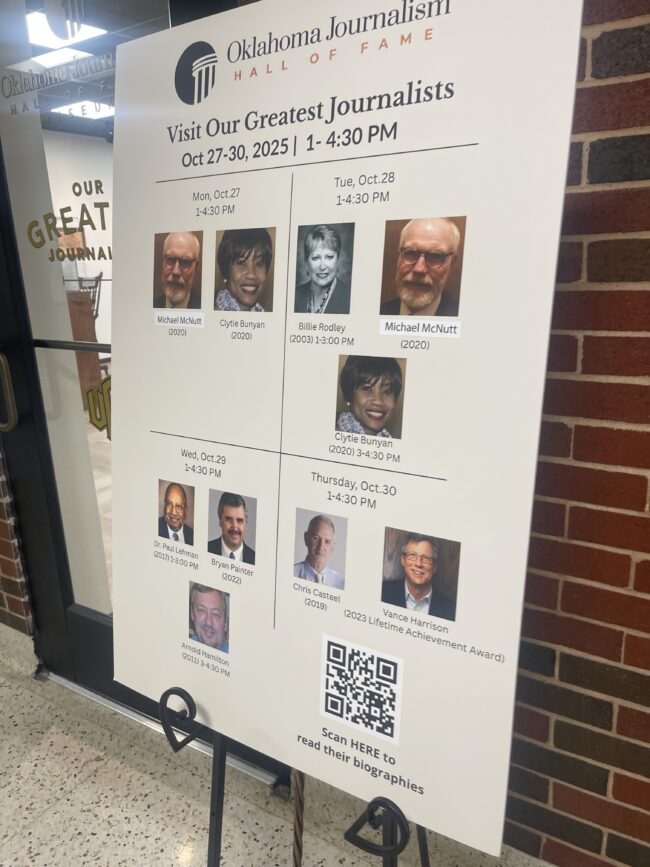Celebrating 55 Years of Excellence: Hall of Fame Journalists Reflect on Oklahoma’s Media Legacy

The Oklahoma Journalism Hall of Fame celebrated its 55th anniversary with the “Visit Our Greatest Journalists” series, a weeklong event held Oct. 27–30 at the newly opened Hall of Fame Museum in the University of Central Oklahoma’s Liberal Arts Building.
The event invited students and visitors to engage with Hall of Fame members whose work has shaped journalism in Oklahoma and beyond.
Among the featured guests were Chris Casteel, Dr. Paul Lehman, and Bryan Painter, who shared stories from their professional careers and provided insight into the values that continue to define journalism today.
For longtime Oklahoman reporter Chris Casteel, being part of the anniversary event was both personal and meaningful. “It means a lot,” he said.
“I spent my whole career in journalism, working for the Oklahoma City paper. I always wanted to be a journalist, and journalism has always meant everything to me.”
Casteel spent nearly three decades in Washington, D.C., covering national politics for The Daily Oklahoman, and described his 2019 Hall of Fame induction as an honor that represented his career-long commitment to the profession.
“I helped write a lot of the political history of this state during the time that I was working for The Daily Oklahoman,” he said, adding that Hall of Fame Director Joe Hight “does a fantastic job of recognizing the history of journalism in Oklahoma.”
As he looked through the museum’s exhibits, Casteel said it’s impossible to represent journalism through artifacts alone. Still, the displays “do a good job of showing how communication and storytelling evolved.”
He reflected on key moments in his career, including covering Barack Obama’s and Hillary Clinton’s historic presidential nominations and major Supreme Court decisions.
“Those were proud moments in American history,” he said. “Even though we’re objective reporters, we’re also Americans, and there’s a sense of patriotism in witnessing those milestones.”
Casteel also discussed how journalism has changed, noting that fewer people read printed newspapers, but new opportunities have appeared online. “Coverage hasn’t gone away; it’s just migrated online in different forms,” he said.
“What matters are the basics: accuracy, fairness, and integrity. Those don’t change.” He added that no matter how the mechanics evolve, journalists must always strive to “give readers a true and balanced picture of what you’re covering.”
On Wednesday, Lehman and Painter, both Hall of Fame members, continued the discussion about journalism’s legacy. Lehman, who became Oklahoma’s first African American television journalist in 1968, described his experience as both difficult and fulfilling.
“Most of the reaction was negative because of the social environment then,” he said. “But it was also an opportunity to build something positive.”
Painter, who joined The Oklahoman under then-editor Joe Hight, shared one of his most significant experiences: reporting on the 1995 Oklahoma City bombing.
“My stories weren’t about how they died but who they were in life,” he said. “Each of those individuals had a name and a story. That influenced how I viewed journalism.”
Both journalists highlighted the enduring importance of accountability and accuracy in reporting. Painter said he learned early on to “wrap everything in accuracy” because “if you don’t get it right this time, you may not get another chance.”
Lehman said the museum’s exhibits remind visitors of “the dedication and commitment of the people represented here” and the ongoing need to “respect and maintain the First Amendment.”
When asked what advice they would give to young journalists, Lehman encouraged them to discover and pursue their passion. “When you do that,” he said, “it won’t feel like work; it’ll feel like purpose.” Painter agreed, saying that despite technological advancements, “the responsibility does not change.”
The new Hall of Fame Museum, located in Room 145 of the Liberal Arts Building, is open to the public weekdays from 1 to 4:30 p.m. through Dec. 12. The “Visit Our Greatest Journalists” series not only recognized decades of outstanding reporting but also reminded visitors that while tools and technology change, the core values of journalism remain constant: truth, accuracy and human connection.

